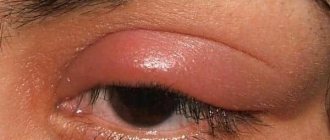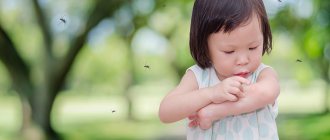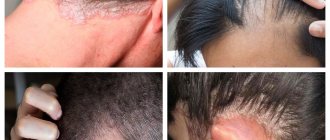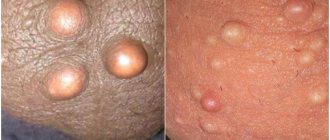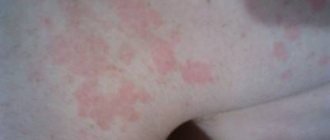Reactions to insect bites are painful conditions that develop due to the body's sensitivity to components of the poison or saliva that enter the body during bites. They can be allergic and toxic and in some cases can cause death. Every 10th inhabitant of our planet suffers from allergies to insect bites; Particularly dangerous in this regard is the venom of hymenoptera insects, which can initiate the development of anaphylaxis and lead to death.
The Allergology Department of CELT offers treatment for a child’s or adult’s reaction to insect bites in Moscow. Our multidisciplinary clinic employs leading domestic specialists who have modern diagnostic and treatment facilities and practice modern methods for eliminating allergic and toxic reactions. You can make an appointment with them online or by contacting our operators: +7 (495) 788-33-88
At CELT you can get advice from an allergist.
- Initial consultation – 3,500
- Repeated consultation – 2,300
Make an appointment
Etiology of reactions to insect bites
Allergic and toxic reactions are caused directly by bites and other effects of various insects. Hymenoptera pierce the skin with a sting and release poison into the resulting wound, to which the body can react accordingly. So, bites:
- mosquitoes are accompanied by itching and an allergic reaction with swelling, rash, and sometimes fever;
- fleas cause dematoses, increased body temperature, and a rash similar to hives;
- bedbugs provoke various reactions, ranging from ordinary itching to anaphylactic shock;
- mosquitoes cause the formation of itchy papules, burning skin, nausea, vomiting, secondary rashes;
- Horseflies cause local swelling, redness, the appearance of tumors, swelling of the lymph nodes;
- midges lead to the formation of papules, swelling, development of hyperemia and tachycardia.
Fly bite: local symptoms and physiological changes
The body's reaction to a fly bite occurs due to mechanical damage to the skin and the toxic effect of saliva, and symptoms may be local in nature or reflected in changes in the general condition of the body. Farm animals suffer from attacks of blood-sucking parasites much more than humans.
A small pinpoint wound and a red bump around it are the main external manifestations of a fly attack. After an attack by a large number of insects, the body may be covered with many bites located at some distance from each other. The following symptoms indicate complications:
- redness and swelling increase;
- children may develop hives;
- suppuration has formed near the wound due to the penetration of a secondary infection;
- The elevated body temperature does not subside for several days, general weakness and sleep disturbance are observed.
In animals, after multiple and regular fly bites, the volume of milk yield, meat gain, and the quality of wool deteriorate significantly. Scratches, ulcers and other damage that require treatment appear on the skin.
Types of reactions to insect bites
As already mentioned, there are allergic and toxic reactions that develop as a result of Hymenoptera bites.
| Type of reaction | How are they manifested? |
| Allergic reactions to insect bites | Presented in four types depending on clinical manifestations:
|
| Toxic reactions | Characteristic of bites by a large number of Hymenoptera. They appear as follows:
If the victim is bitten by a large number of bees or wasps, he may die. |
Prevention on the street
While the child is small, it is easy to cover him with a mosquito cover right in the stroller. In some cases, it is convenient to use protective clothing or tents with mosquito nets. In all other situations, repellents become almost the only protective measure. Modern repellents typically use one of these two main active ingredients - DEET or picaridin.
DEET (diethyltoluamide) is the most commonly used broad-spectrum ingredient that is effective against mosquitoes, biting flies, fleas and ticks. In most cases, a repellent containing up to 10% DEET will prevent mosquito bites. In areas at high risk of insect-borne infections (where malaria, Ross River virus, Barmah Forest virus and Dengue fever occur), repellents with a DEET concentration of 15–30% should be used.
DEET can be safely applied to cotton, wool and nylon, but can damage spandex, rayon, acetate and leather clothing. DEET can dissolve plastics and vinyl (such as sunglass frames or watch bands).
Picaridin is a new repellent ingredient that is odorless and less sticky than DEET. May be more pleasant to use, does not dissolve plastic. Studies have shown that picaridin is as effective as DEET; however, its protection is less long-lasting and it will need to be applied more frequently. Products containing 10% picaridin will prevent insect bites in most situations.
Safety of using repellents in children
Before use, read the label, assess the level of DEET or picaridin in the product, and use the repellent only as directed by the manufacturer.
Follow simple rules:
- Choose roll-on medications over aerosols if you have a choice.
- Apply a moderate amount of the drug to exposed skin.
- Do not apply the drug to cuts, wounds or irritated skin.
- Do not apply to areas around the eyes or mouth (in case of accidental contact with eyes, rinse immediately with plenty of water!).
- Do not apply to the palms or fingers of small children.
- When you return home, wash the repellent off your skin with soap and water.
- Keep repellents out of the reach of children.
- If you need to apply both sunscreen and repellent, apply the sunscreen first. Products that combine sunscreen and repellent are not recommended by experts, as sunscreen usually needs to be reapplied, but repellent does not.
Physical methods of protection
Mosquitoes are attracted to dark colors, so you should wear light-colored clothing that covers your wrists and ankles to reduce the likelihood of being bitten. If you are planning to travel to high-risk areas, it is recommended that you obtain medical advice before traveling; you may need additional vaccinations against infections and/or drugs to prevent malaria.
Stagnant water attracts mosquitoes, so stay away from dams, ponds, swamps and other areas with standing water.
To prevent mosquitoes from breeding near your home:
- Cover all water containers (including swimming pools) to prevent mosquitoes from laying eggs there.
- Empty all water containers when not in use.
- Change the water in used containers at least once a week.
- Cover cesspools and septic tanks to prevent mosquitoes from laying eggs in them.
- Remove excess vegetation from garden ponds and stock the ponds with fish.
- Avoid overwatering your garden.
Symptoms of a reaction to insect bites
Experts distinguish three types of reactions to Hymenoptera bites:
- Common – the affected area is swollen, red, itchy and painful;
- Large local – tumor diameter exceeds 50 mm;
- Systemic - reactions occur not only in the area of the bite, but also in parts of the body remote from it.
A local reaction on the skin can last from two to three hours to several days, and maybe up to 24 months. In this case, it is important to differentiate the reaction to a bite from a neoplasm of a benign or malignant nature. It is worth noting that the symptoms of reactions are very diverse and range from minor pain to anaphylactic shock. As for local reactions, the picture is similar here too: from a small papule to swelling of the affected arm or leg.
Prevention at home
The basis for protection against midges in the house are mosquito nets and fumigators. Attention! Remember that a mosquito net increases the risk of a child falling from a window, as it creates the illusion of a barrier - use window blockers.
Fumigators can work on plates or liquid, slowly spraying a substance toxic to insects around them. The substance most often used in fumigators is ethok (also known as prallethrin).
A common question for pediatricians is “my child found and chewed a fumigator plate, what does this mean for him?” The fumigator plate contains about 9 mg of prallethrin. The oral toxic dose of prallethrin for humans is 600 mg/kg (LD50). Thus, neither eating these plates nor inhaling fumes from a fumigator can usually cause serious harm to a child, but getting repellents and chemicals for fumigators into the mouth and mucous membranes should still be avoided.
You can read more about the use of repellents and fumigators on the Rospotrebnadzor website.
Diagnosis of reactions to insect bites
The main task of an allergist who makes a diagnosis is to conduct a full medical history, which will allow you to establish the following:
- Previously noted reactions to insect bites;
- The presence of a bite by Hymenoptera;
- What kind of insect bit the patient?
In addition, an examination is carried out, as well as additional diagnostic studies aimed at identifying reactions in the form of disruption of systems and internal organs. They may be as follows:
- Ultrasound scanning of the peritoneal organs;
- Electrocardiography;
- Allergy tests.
General recommendations
Each insect bite causes a local response of varying severity. People who don't have allergies just wait for it to go away. To alleviate your condition, you can take certain measures:
- Applying ice to the bite site;
- Applying a vinegar solution to the affected area;
- Rinsing the wound under cold water (in case of stings from wasps, bumblebees, bees, etc.)2.
You should not get carried away with folk remedies, especially herbal decoctions or alcohol tinctures, which can aggravate the situation. It is recommended to avoid any foreign protein structures at the site of the allergen.
Our doctors
Orlova Tatyana Vladimirovna
Doctor - allergist-immunologist, pulmonologist, doctor of the highest category
Experience 38 years
Make an appointment
Shundeva Oksana Veniaminovna
Allergist, doctor of the highest category
Experience 39 years
Make an appointment
Insect bites
- Insect bites can cause allergic reactions, local infections and systemic diseases.
- In Russia, insect vectors spread Lyme disease, tick-borne encephalitis, tularemia, Pogosta disease and encephalitis caused by the Inkoo virus.
- An allergy to wasp or bee stings can lead to an anaphylactic reaction.
- If you are allergic to mosquito bites, preventative use of antihistamines may help.
Symptoms
- When an insect bites, an erythematous spot first appears on the skin, which can enlarge like a blister.
- There is usually a small petechiae in the center of the bite site.
- A skin reaction is a combination of exposure to insect venom and the body's immunological response, which accounts for the wide range of individual differences in reactions.
- Delayed allergic reactions can develop after insect bites. In their place, itchy papules or nodules remain for several weeks.
- With anaphylaxis, extensive erythema and swelling usually develop at the site of the bite, followed by general symptoms such as malaise and low blood pressure within a few minutes.
- In addition, acute urticaria and generalized or limited itching of the palms and soles are possible.
- Anaphylactic reactions are especially common in individuals with an allergy to hymenoptera stings. See the Hymenoptera section below for information on testing and treatment.
Complications caused by insect bites
- Severe local reaction (painful erythema, swelling, angioedema) near mucous membranes (eg, pharynx or lips) can lead to airway obstruction.
- A purulent skin infection (pyoderma) may develop at the site of the bite. It is especially typical for tourists. See the article about skin problems among tourists.
- There are rare cases of an abscess, erysipelas or cellulitis at the site of the bite.
- In individuals sensitized to Hymenoptera venom, a bite can lead to an anaphylactic reaction.
- Clinically significant infections spread by arthropods in Russia: Lyme disease and tick-borne encephalitis (both diseases are spread by ticks)
- tularemia, spread by mosquitoes, sometimes ticks, midges or horse flies
- Pogosta disease and encephalitis caused by the Inco virus (both diseases are spread by certain types of mosquitoes).
Research
- Diagnosis is made based on history and clinical examination
- It is important to evaluate the site of the bite (ringed erythema, necrotic papule or ulcer, photograph) and other skin symptoms (eg, urticaria, pruritus), as well as mucosal and general symptoms (fever, joint and neurological symptoms).
- The diagnosis of erythema migrans of Afzelius-Lipschutz and tularemia (ulcer covered by an eschar) is clinical, which implies initiation of therapy based on the clinical picture.
- For anaphylaxis caused by hymenoptera venom, it is necessary to perform skin prick tests and tests for specific serum IgE antibodies to wasp and bee venom.
- For purulent infection of the bite site, bacteriological culture may be required.
- In doubtful cases, histological examination of a skin biopsy may show a typical reaction to an insect bite, which, however, is not an absolute diagnostic criterion.
Diptera (mosquitoes and flies)
Mosquitoes
- A mosquito bite causes the rapid appearance of a urticaria-like papule, which almost always disappears spontaneously, but in sensitized individuals can persist for a long time and be accompanied by itching.
- Large papules and even vesicles may appear.
- Antihistamines, such as Cetirizinum (cetirizine) 10 mg 1 time / day, reduce the symptoms of mosquito bite allergy, especially when taken prophylactically.
Midges
- Midges cannot bite through clothing, but they can bite when crawling under it. Many people develop papules that can last up to several weeks.
- Individuals allergic to their venom may develop extensive swelling of local tissues.
- Midge bites usually cause severe itching, and scratching can lead to ulceration or secondary infection.
Horseflies
- A horsefly bite usually causes a large papule with a pale spot in the center.
- Treatment For local treatment, you can use ointments with class II–III glucocorticosteroids or their combination with an antiseptic 1–2 times a day. within 1–2 weeks.
- If there is a secondary infection at the site of the bite, it is recommended to use antibacterial ointments or creams 2-3 times a day for 1 to 2 weeks.
- Wet, cold compresses or cooling gel may help relieve symptoms.
- In case of severe reactions, a 3-day course of oral glucocorticosteroids, for example, Prednisolonum (prednisolone) 40 mg/day, may be indicated.
Hymenoptera
- Due to the ingestion of venom at the site of a wasp, (honey) bee or bumblebee sting, severe pain and swelling immediately occur.
- Worldwide, sensitization to Hymenoptera venom causes many potentially fatal anaphylactic reactions each year.
- Individuals who are allergic to wasp venom are usually not allergic to bee venom and vice versa.
- Treatment The bite site must be immobilized to prevent further spread of the venom.
- A bee sting remaining in the skin must be quickly removed to prevent the entire contents of the venom reservoir from being emptied into the skin. It is best to scrape it off the skin with a thin, flat object (bank card, coin). A wasp or bumblebee does not leave a stinger in the skin.
- Suitable first aid measures: cold compresses, lotions or cooling gel.
- Individuals with multiple bites should be monitored for systemic reactions.
- Anaphylactic reactions Acute anaphylactic reactions are treated as anaphylaxis and future exposure to hymenoptera should be avoided.
- After the development of a systemic reaction (anaphylaxis) to a Hymenoptera bite, allergy tests are recommended.
- First aid: the patient should carry with him an anti-shock kit, including a solution of Adrenalini hydrochloridum (adrenaline hydrochloride) 0.1% 1.0 ml in ampoules; in addition, 40 mg of Prednisolonum (prednisolone) and an antihistamine, for example, in the form of lozenges, are used once.
- Examinations for anaphylaxis The diagnosis of allergy to hymenoptera venom is made with positive skin prick test results and/or detection of IgE antibodies to bee or wasp venom after an anaphylactic reaction. The IgE reaction can be determined only 1–2 months after the bite.
- If both tests are positive, a test for allergen-specific IgE antibodies can be performed to identify the true cause of the allergy.
- In such cases, it is also recommended to send a serum sample for immunochemical analysis (spot immunoassay), if this service is available. Unfortunately, this technique is not used in the Russian Federation.
- If a patient has had a typical systemic reaction to hymenoptera venom, but specific IgE tests are negative, these tests should be repeated and, in consultation with an allergist, the need for special tests should be considered.
- Measurement of serum tryptase concentration is recommended to rule out mastocytosis in patients who have had an anaphylactic reaction to hymenoptera venom. The analysis should be carried out in a non-acute phase (for example, 1-2 months after the reaction).
- Desensitization (allergy to Hymenoptera venom) Severe systemic reaction (local reaction and symptoms from the cardiovascular or respiratory systems) to the sting of Hymenoptera (wasps or bees) is an absolute indication for desensitization.
- In case of a mild systemic reaction (local reaction and urticaria or swelling of the mucous membranes), the need for desensitization may be considered if there is a high likelihood of a recurrent bite or fear of it affects the patient's quality of life.
- In case of extensive local reactions, desensitization is not indicated.
- In patients with an allergy to Hymenoptera venom, desensitization should be continued for 5 years, after which in almost all (at least 80%) its effectiveness remains for at least 7 years.
- Knowing that desensitization will likely prevent anaphylactic reactions improves quality of life.
Lice (Anoplura)
- Blood-sucking species that parasitize humans: head, body and pubic louse.
- Head lice epidemics can occur in schools and kindergartens.
- Body lice are now rare; they appear predominantly in alcoholics and people leading an antisocial lifestyle.
- For disinfection, regular washing of clothes in a washing machine is sufficient.
- Pubic lice are usually transmitted sexually; symptoms: itching and pustules in the genital area, nits in pubic hair.
Bedbugs and fleas
- Bedbugs live in old, dirty buildings. They can be transported with old furniture. Bedbugs suck blood at night.
- Small insects that parasitize birds, dogs, cats (for example, ticks of the genus Cheyletiella) and rodents also bite humans. Most often, symptoms appear in the spring (in people who work in a poultry house or go to country houses for the first time after winter).
- Bedbug and flea bites cause hard, intensely itchy papules with a bite mark (petechiae) in the center. They are most often noted on areas of the skin covered by clothing.
- Skin manifestations may persist for several days, with symptoms developing only in sensitized patients.
- A blister or extensive swelling may immediately appear at the site of the bite, which can easily be confused with erysipelas or another bacterial infection.
- Papules usually appear in groups at the site of multiple bites, but rows of bites are also common.
- Fleas cause papular urticaria, sometimes seen in children in the summer (strophulus). The patient is usually unaware of the causes of the rash, which makes diagnosis difficult.
- For the reaction to develop, sensitization is necessary, which is why symptoms do not appear in all family members.
- Treatment For bedbug and flea bites, it is usually sufficient to use an ointment or solution with a class II-III glucocorticosteroid 1-2 times a day. within 1–2 weeks.
- Disinsection of bedbugs in residential buildings requires special knowledge of where they can hide and how to destroy them, and calling a special service.
Larvae
- The hairs of the larvae of some butterflies (for example, the crimson cocoon moth) can cause toxic and allergic reactions.
Ticks
- The Ixodes ricinus tick is a carrier of Lyme disease, tick-borne encephalitis, and rarely, tularemia.
- Tick bites are painless and may go unnoticed.
- In Russia, ticks are active from April to November, and their favorite habitat is lawns, grass, low bushes and grassy cover in wooded areas.
- High boots and trousers are best for protection.
- When entering tick habitat areas, you must inspect your skin and clothing every evening and remove them if found.
- For Borrelia to be transmitted from a tick to a person, the tick must remain in the skin for at least several hours or even days; therefore, it needs to be found and removed as quickly as possible. The most common symptom of early Lyme disease is an expanding migratory annular erythema (EM), which appears within a week around the site of the tick bite.
- Within a few days or weeks, the erythema usually reaches a size of 5–10 cm, sometimes much larger, and may subsequently disappear spontaneously.
- Typically, a skin lesion of 5 cm in diameter observed within 5 days of a tick bite indicates ME. The faster, smaller reactions may be an inflammatory response to components of the mite's saliva.
- Lyme disease is always diagnosed based on clinical signs. In the vast majority of cases, the infection is diagnosed at an early stage, and antibody testing is not practical.
- For diagnosis at later stages, laboratory tests (antibodies to Borrelia in serum) are necessary.
- Removing a tick Grab the tick with tweezers (small, sharp-tipped ones) as close to the skin as possible.
- Try to remove the entire tick by simply slowly pulling it straight up. Don't try to remove it with oils or ointments. If the head of the tick remains in the skin, it can be removed with a needle after disinfecting the skin.
Spiders
- In the Russian Federation there are karakurt, tarantula, etc.
- Spiders usually bite a person only when accidentally pressed against the skin.
- The most dangerous spider in Russia is the karakurt. If not treated promptly, its poison can be fatal. Serum injection is required. The venom of the South Russian tarantula is not life-threatening, but can lead to swelling, severe pain at the site of the bite, and an allergic reaction. The effect of a water spider (Argyroneta aquatica) bite is similar to that of a wasp.
- Bites from huntsman's border and large cross spiders can be painful.
- They are treated like hymenoptera bites.
Protection against insect bites
- Clothing should cover as much of the body as possible, which is especially important for young children.
- Light-colored clothing with long sleeves and long legs is preferred. Mosquitoes, for example, can bite through thin fabric.
- It is recommended to wear a hat on your head; your ankles and feet can be protected with socks and shoes. The legs can be tucked into socks. Closed shoes are preferable to sandals.
Repellents
- Active ingredients of repellents sold in Russia: diethyltoluamide (DEET), icaridin.
- The repellent's effect usually lasts several hours, but intense sweating shortens this period.
- The strength and period of action of repellents are interdependent, i.e. The stronger the repellent, the longer the duration of its action.
- It is preferable that the concentration of the active substance in mosquito repellents be at least 20%.
- Repellents containing DEET in concentrations above 35% can be recommended in the presence of a really large number of mosquitoes, if the repellent quickly evaporates from the skin, as well as for persons traveling to tick habitats.
- 50% solutions are effective against ticks, and 20% are effective against mosquitoes, midges and midges if used according to package instructions.
- Repellents are not effective against deer beetles, wasps, bees and bumblebees.
Information provided from source
Quantity
How long does a midge bite take to heal?
How long the swelling from a bite lasts depends on your health condition. On average this is:
- For mild skin reactions – from 1 to 4 days.
- For local allergies – from 4 days to 1.5 weeks.
- For an initially severe allergic reaction – from 1 to 2 weeks.
In addition to allergies, the duration of the presence of edema can also be affected by the location where it is located and the rate of metabolic processes in the body. With proper treatment and supportive care, intense swelling in most cases is relieved within 1–3 days; further recovery gradually eliminates the remaining symptoms within 10–14 days. How long the bite lasts and how long it takes for it to heal completely so that not a trace remains of it depends on the speed of skin cell regeneration, which is also highly individual and can take from a week to 1 month or more.
Treatment with tablets
Not in all cases, medications in the form of ointments and gels show high effectiveness in eliminating the negative consequences of bee, wasp and other insect bites.
To increase their medicinal effect, you can additionally use oral medications (Benadryl, Diphenhydramine, etc.). In addition, in case of severe inflammation, it is necessary to additionally use antimicrobial medications in tablet form. Severe manifestations require injections of the drug Epinephrine.
Ticks
They are active from March to October. They live in grass and small bushes. You are more likely to be bitten while relaxing in nature. The tick explores the body for a while, chooses the most favorable place, and then bites into it. The process of a tick bite almost always remains unnoticeable; for several days the arachnid can calmly drink blood and stick around in the body. It is discovered either by chance or itching occurs.
On a note!
Ticks have the ability to fall off on their own once they are fully saturated, but are more often discovered before this point. The head of the pest is under the skin, the body sticks out. You can pull it out yourself using tweezers, thread, or seek help from specialists.
If you couldn’t catch a tick while it was hot, bites can be recognized by the following signs:
- redness with a diameter of 1.5 cm;
- in the center there is a dark spot with dried blood;
- lump from a bite, compaction;
- inflammation;
- itching
The skin is restored without special treatment in 7 days. If the tick was a carrier of encephalitis, after 14 days your health worsens and flu-like symptoms appear. You need to immediately seek help from specialists, get tested, and be sure to report a tick attack.
Tick bite
First aid
If the negative symptoms are severe, the victim should immediately call an ambulance. Before the doctors arrive, you need to do the following:
- thoroughly rinse the bite area with running water and laundry soap;
- apply an anti-inflammatory drug to the skin;
- avoid scratching the bite;
- minimize swelling by applying cold to the damaged area;
- treat the bitten area with an antihistamine (Fenistil, etc.);
- Give the victim antihistamines (for example, Suprastin).
Most often, complications can be prevented. However, if you have an allergic reaction, you cannot do without medical help.
If a tick is found under the skin, you should immediately contact a surgeon so that he can remove the parasite in the most effective and safe way. If you cannot see a doctor, you will have to perform the procedure yourself. For this purpose, you need to use small forceps.
The affected area should be treated with a good antiseptic: iodine, chlorhexidine, alcohol or hydrogen peroxide.
The insect removed from the skin must be placed in an airtight glass container. It must be taken to the laboratory for testing within 2-3 days.
If the victim experiences anaphylactic reactions, the following should be done:
- First you need to call an ambulance.
- The victim needs to take a horizontal position and slightly raise his lower limbs.
- After this, you need to apply something cold to the affected area of the skin.
- If the victim loses consciousness, his respiratory function must be carefully monitored. When it stops, emergency resuscitation measures should be carried out (artificial respiration, cardiac massage, etc.).
- If the victim is in a conscious state, he needs to be given antihistamine medications (Tavegil, Suprastin, etc.). Additionally, an injection of Epinephrine should be given in a dosage of 0.1 to 0.3 ml.
- In case of severe pain, you need to take painkillers.
The visiting medical specialists need to tell you as much as possible about what happened. After this, the victim is taken to the hospital and undergoes a thorough diagnosis to identify the cause of the condition and select the optimal method of therapy.
Ants
This is the case when an insect bit, and who exactly remains to be seen. Ants do not attack people, but they can crawl into things and onto the body while in nature. It is not difficult to crush a tiny insect, followed by a painful bite and an injection of acid.
Traces from insect bites - ants, differ from others by the presence of a white formation in the center. There is a red spot around. The size in diameter does not exceed 1 cm. Severe swelling after an insect bite appears only in case of individual intolerance to ant poison. The formation on the skin occurs gradually over 1 week; to accelerate the effect, pharmaceutical preparations and folk remedies are used.
Insect bites
House fleas
Flea wounds are numerous and stand out with clearly visible red spots at the site of the bite. This is due to the fact that during a bite the flea plunges its entire head into the wound. The danger of fleas lies in the fact that they are parasitic insects, that is, diseases from animals can be transferred to humans. They are the causative agents of diseases such as anthrax, brucellosis, various types of typhus, and fleas can live for up to 3 years. And she will infect her owners, and see how fleas get into your apartment here.
What is forbidden to do after a bite
After a bite, do not scratch the affected area or expose it to prolonged exposure to direct sunlight. In addition, the damaged area must be protected from contact with chemicals and aggressive influences.
When bitten by ticks, it is forbidden to use improvised devices for extracting the parasite (pins, tweezers, etc.), because the head of the insect can remain in the epidermis and provoke a severe inflammatory process and additional complications.
Experts also do not recommend burning ticks, because such manipulation will force the parasite to go deeper into the epidermal layers. You shouldn’t crush an insect either, because pathogenic microorganisms that may be present in it will enter the bloodstream and provoke the development of an infectious disease.
Bitten areas should not be treated with fatty substances (oil, kerosene, etc.), because they can lead to the fact that the tick does not have time to get out and remains in a dead state in the skin.
In addition, when bitten, the victim should not be left alone, and the sting remaining in the skin should not be squeezed while removing it.

